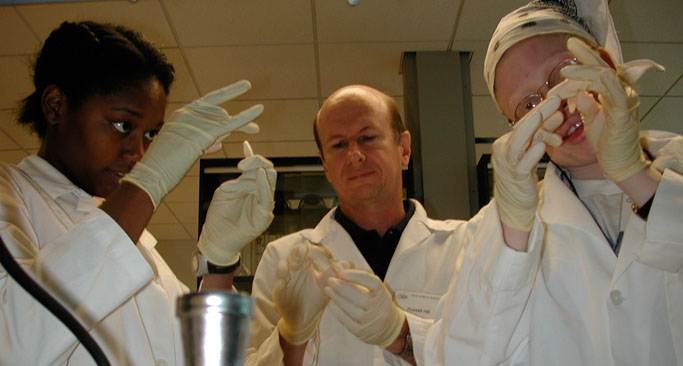
What is DNA Extraction?
Simply put, DNA Extraction is the removal of deoxyribonucleic acid (DNA) from the cells or viruses in which it normally resides.
Simply put, DNA Extraction is the removal of deoxyribonucleic acid (DNA) from the cells or viruses in which it normally resides.
What is it used for?
Extraction of DNA is often an early step in many diagnostic processes used to detect bacteria and viruses in the environment as well as diagnosing disease and genetic disorders. These techniques include but are not limited to -
Extraction of DNA is often an early step in many diagnostic processes used to detect bacteria and viruses in the environment as well as diagnosing disease and genetic disorders. These techniques include but are not limited to -
- Fluorescence In Situ Hybridization (FISH): FISH is a molecular technique that is used, among other things, to identify and enumerate specific bacterial groups.
- Terminal Restriction Fragment Length Polymorphism (T-RFLP): T-RFLP is used to identify, characterize, and quantify spatial and temporal patterns in marine bacterioplankton communities.
- Sequencing: Portions of, or whole genomes may be sequenced as well as extra chromosomal elements for comparison with existing sequence in the public data base.
How does it work?
Outline of a basic DNA Extraction -
Outline of a basic DNA Extraction -
- Break open (lyse) the cells or virus containing the DNA of interest-
This is often done by sonicating or bead beating the sample. Vortexing with phenol (sometimes heated) is often effective for breaking down protienacious cellular walls or viral capsids. The addition of a detergent such as SDS is often necessary to remove lipid membranes. - DNA associated proteins, as well as other cellular proteins, may be degraded with the addition of a protease. Precipitation of the protein is aided by the addition of a salt such as ammonium or sodium acetate. When the sample is vortexed with phenol-chloroform and centrifuged the proteins will remain in the organic phase and can be drawn off carefully. The DNA will be found at the interface between the two phases.
- DNA is the precipitated by mixing with cold ethanol or isopropanol and then centrifuging. The DNA is insoluble in the alcohol and will come out of solution, and the alcohol serves as a wash to remove the salt previously added.
- Wash the resultant DNA pellet with cold alcohol again and centrifuge for retrieval of the pellet.
- After pouring the alcohol off the pellet and drying, the DNA can be re-suspended in a buffer such as Tris or TE.
- Presence of DNA can be confirmed by electrophoresing on an agarose gel containing ethidium bromide, or another fluorescent dye that reacts with the DNA, and checking under UV light.

Picture of viral DNA that has been electrophoresied on an agarose gel. The DNA was extracted from the thermal STIV virus and cut with three separate restriction enzymes. (picture supplied by the author)
Instrumentation used in DNA Extraction -
This bead beater is used in the breaking apart or "lysing" of cells in the early steps of extraction in order to make the DNA accessible. Glass beads are added to an eppendorph tube containing a sample of interest and the bead beater vigorously vibrates the solution causing the glass beads to physically break apart the cells. Other methods used for lysing cells include a french press and a sonication device.
A centrifuge such as this can spin at up to 15,000 rpm to facilitate separation of the different phases of the extraction. It is also used to precipitate the DNA after the salts are washed away with ethanol and or isopropanol.
A gel box is used to separate DNA in an agarose gel with an electrical charge. When the red and black leads are plugged into a power supply the DNA migrates through the gel toward the positive charge due to the net negative charge of the molecule. Different sized pieces of DNA move at different rates, with the larger pieces moving more slowly through the porus medium, thereby creating a size separation that can be differentiated in a gel.


